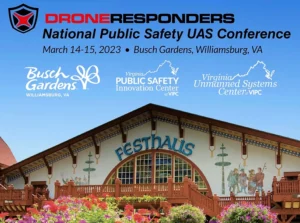 The sold out DRONERESPONDERS National Public Safety UAS Conference kicked off today in Williamsburg VA, with an international guest list and a packed schedule of training and presentations.
The sold out DRONERESPONDERS National Public Safety UAS Conference kicked off today in Williamsburg VA, with an international guest list and a packed schedule of training and presentations.
Continue reading below, or listen:
One of the earliest applications for public safety drones was in Search and Rescue, and Gemma Alcock has been on the forefront of those efforts. Alcock founded SkyBound Rescuer in 2016, and has worked closely with international public safety agencies including then UK’s Royal National Lifeboat Institution (RNLI). In addition to her role as founder and CEO of SkyBound Rescuer, Alcock is currently the Director of Air Services at Lowland Rescue, a UK-based SAR charity that searches for missing vulnerable people on behalf of police forces.
The Response Challenge: Manned Aircraft, Foot Teams and Drones in Search and Rescue
One of the primary challenges in search and rescue (SAR) operations is time. The more time it takes for search teams to respond to a request from a public safety agency – and then to get set up and start searching – the longer it will be before a person can be rescued, and the lower the chance of survival. In remote areas – where SAR may be most needed – response times can be painfully slow.
There are multiple factors that contribute to slow response times. Manned aircraft like helicopters are expensive and in short supply: in the UK, SkyBound Rescuer’s research indicates that manned aircraft teams accept only 54% of all requests for service, turning down almost half of the agencies that need them. While much less expensive, manual drone teams are also not readily available: and they need time to drive the drone to the search and set up a flight. “Drones are rarely first on the scene, yet that’s where they can add the most value,” Alcock points out. Local drone teams are still working in silos, which means that hardware, training, and flight protocols can be very different, even between two emergency services in the same county.
“These challenges create greater levels of risk for responders,” says Alcock. “If an aircraft is too slow to respond, emergency services need to go in to dangerous situations without an eye in the sky to support them.”
SkyBound Rescuer’s Vision for the Future: Automated Drones Where They Are Needed
SkyBound Rescuer is addressing these needs right now by providing software solutions to help teams mission plan and operate more effectively and more quickly. Their big vision for the future, however, is to eliminate the need for trained pilots on site for every operation, through the SkyBound Network.
SkyBound Network is an international network of automated drone stations – drone-in-a-box solutions – positioned in high risk areas: along coastlines, in rugged terrain, or even in high crime areas. These drones would be always ready, ideally responding within 5 minutes of a request for help – almost an hour faster than most response times for a Coast Guard helicopter in the U.K.
SkyBound plans to invest in the infrastructure and work on a lease model: because the costs of the automated drone stations can be shared across agencies, it’s a cost-effective model without capital costs. The solution give first responders access to drone data without having to be onsite to fly the drone, or to have trained pilots on call to drive to search sites.
Tests of the SkyBound Network have given compelling results: an 8 minute response time compared to 73 minutes for a foot SAR team, or 65 minutes for a manned drone team. The search itself took only about 13 minutes compared to more than 2 hours for both the foot and manual drone team: and operation required only 1 person with no drone training.
As drone regulations progress – and implementations of automated drone solutions become more common around the world – the SkyBound Network has the potential to change the way drones are used in search and rescue. For missing persons, Gemma Alcock says that the speed the Network offers will make a life or death difference.
“The faster we get there, the faster we find them, the faster we deliver them to definitive care,” says Alcock. “That makes a real difference in outcomes. That’s saving lives.”
Read more:
- Garuda Aerospace Drones Deployed in Turkey for SAR, Relief Efforts
- Japans Night Hawks Fly Drone SAR Missions After Dark in Nishikawa
- Elbit Tests SAR Drones for UK Coastguard
- EU Drone Laws Change January 1: SkyBound Rescuer Makes it Easy with Free Drone License Finder
- Draganfly Medical Response, Search and Rescue Drones Go to Ukraine

Miriam McNabb is the Editor-in-Chief of DRONELIFE and CEO of JobForDrones, a professional drone services marketplace, and a fascinated observer of the emerging drone industry and the regulatory environment for drones. Miriam has penned over 3,000 articles focused on the commercial drone space and is an international speaker and recognized figure in the industry. Miriam has a degree from the University of Chicago and over 20 years of experience in high tech sales and marketing for new technologies.
For drone industry consulting or writing, Email Miriam.
TWITTER:@spaldingbarker
Subscribe to DroneLife here.







[…] expanding the toolkit available to ground teams without compromising on capabilities. The DJI Dock, for instance, facilitates autonomous charging and deployment, allowing for rapid response and […]